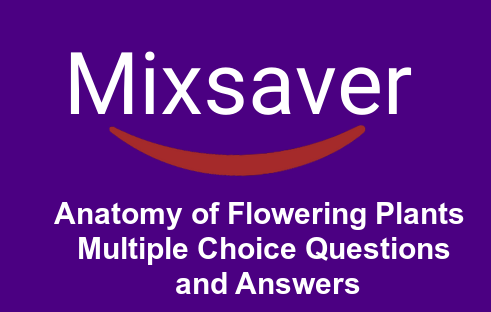Anatomy of Flowering Plants NEET Questions
1. Undifferentiated ground tissue characteristically occurs in
(a) Zea mays stem
(b) Cucurbita stem
(c) Helianthus stem
(d) Helanthus root
Ans. a
2. Which of the following characteristics differentiates monocot root from a dicot root?
(a) Radial vascular bunales
(b) Less developed large pith
(c) Scattered vascular bundles
(d) Open vascular bundles
Ans. d
3. The guard cells of the stomata present in the epidermis of dicot stems are
(a) dumb-bell shaped
(b) elliptical
(c) rounded
(d) kidney-shaped
Ans. d
4. Sclerenchymatous hypodermis is found in
(a) monocot roots
(b) dicot roots
(c) dicot stems
(d) monocot stems
Ans. d
5. Casparian strips are the deposition of
(a) cellulose
(b) chitin
(c) suberin
(d) cutin
Ans. c
Internal Structure of Dicot Root | Internal Structure of Monocot Root
6. The oldest layer of secondary phloem in a stem lies
(a) outward to vascular cambium
(b) inward to vascular cambium
(c) inward to primary xylem
(d) outward to primary phloem
Ans. a
7. In an isobilateral (monocot) leaf, the stomata are
(a) usually absent or less abundant in upper epidermis
(b) usually absent or less abundant in iower epidermis
(c) almost equally distributed in upper and lower epidermis
(d) numerous in lower epidermis
Ans. c
8. Phloem parenchyma is absent in the phloem elements of
(a) dicots
(b) monocots
(c) only dicot stem
(d) only monocot stem
Ans. b
9. Bulliform cells occur in the epidermis of
(b) dicot stems
(a) dicot leaves
(b) dicot stems
(c) monocot leaves
(d) monocot stems
Ans. c
10. Root hairs originate from
(a) pericycle
(b) epidermis
(c) endodermis
(d) exodermis
Ans. b
11. Vascular bundle is enclosed within a well-developed sclerenchymatous sheath in
(a) monocot stem
(b) dicot stem
(c) monocot root
(d) dicot root
Ans. a
Anatomy of Flowering Plants NEET mcq | Anatomy of Flowering Plants mcq
12. Y-shaped arrangement of xylem vessels is found in
(a) monocot stem
(b) dieot stem
(c) monocot root
(d) dicot root
Ans. a
13. When the vascular cambium is present between the xylem and phloem, the vascular bundle is called
(a) closed
(b) open
(c) endarch
(d) exarch
Ans. b
14. Scattered vascular bundles are the feature of
(a) monocot stem
(b) dicot stem
(c) monocot leaf
(d) dicot leaf
Ans. a
15. Vascular bundles are completely absent in
(a) angiosperms
(b) gymnosperms
(c) pteridophytes
(d) bryophytes
Ans. d
Anatomy of Flowering Plants neet questions pdf
16. Polyarch vascular bundles generally occurs in
(a) dicot stem
(b) monocot stem
(c) dicot roots
(d) monocot roots
Ans. d
17. Tissue below the endodermis in dicot root, constitute
(a) cortex
(b) pith
(c) hypodermis
(d) stele
Ans. d
18. Cortex in the stem of dicot plant made up of hypodermis, endodermis and
(a) epidermis
(b) pith
(c) cortical cells
(d) None of these
Ans. c
19. Centrally located pith is absent in
(a) monocot stem
(b) dicot stem
(c) Both (a) and (b)
(d) None of these
Ans. c
20. Cortex is known to be lying between
(a) epidermis and endodermis
(b) endodermis and pith
(c) endodermis and stele
(d) hypodermis and endodermis
Ans. d
Anatomy of flowering plants mcq for neet pdf
21. The vascular bundles in dicot stems are
(a) arranged in a ring
(b) scattered
(c) amphicribral
(d) xylem and phloem situated alternately
Ans. a
22. When phloem and cambium are present on both sides a xylem, the vascular bundle is called
(a) collateral
(b) bicollateral
(c) cocentric
(d) radial
Ans. b
23. The oldest layer of the secondary phloem in a stem lies
(a) outward to the primary phloem
(b) outward to vascular cambium
(c) inward to primary phloem
(d) inward to vascular cambium
Ans. c
24. A monocot stem with secondary growth is
(a) Lilium
(b) Cocos
(c) Asparagus
(d) Yucca
Ans. a
MCQ on Anatomy of Flowering Plants
25. Interfascicular cambium develops from the cells of
(a) xylem parenchyma
(b) endodermis
(c) pericycle
(d) medullary rays
Ans. d
26. Anatomically fairly old dicotyledonous root is distinguished from the dicotyledonous stem by
(a) the absence of secondary xylem
(b) the absence of secondary phloem
(c) the presence of cortex
(d) position of protoxylem
Ans. d
27. Cork tissue arises from
(a) phelloderm
(b) periderm
(c) phellogen
(d) phellem
Ans. c
28. The vascular bundles in a typical leaf are
(a) collateral and open
(b) conjoint and concentric
(c) collateral and closed
(d) bicollateral
Ans. c
29. Leaf of a bean plant does not possess.
(a) lenticels
(b) stomata
(c) phloem
(d) guard cells
Ans. a
30. Which of the following statements is not correct about the arrangement of tissues in the dicot root?
(a) The specialised root tissues are seen at the zone of maturation
(b) The epidermis of the root has no cuticle on its outer surface, unlike other epidermal tissues
(c) The pericycle is the outer layer of cells in the vascular cylinder, with the ability to form secondary or branch roots
(d) The star-shaped phloem is located in the centre of the vascular cylinder, with xylem arranged between the arms of phloem
Ans. d
31. Of the following, which is not characteristic of a monocotyledon plant?
(a) Vascular tissue in a ring in the root
(b) Vascular bundles scattered in the stem
(c) Netted venation of leaf vascular bundles
(d) Flower parts in multiples of trees
(e) All of the above
Ans. c
32. Conjoint, collateral and closed vascular bundles are found in the stem of
(a) sunflower
(b) grass
(c) Cucurbita
(d) Aristolochia
Ans. d
33. An anatomical cross section with two to six exarch xylem bundles, small pith, cambium, cork cambium in the pericycle is the characteristic of
(a) dicot root
(b) dicot stem
(c) monocot root
(d) monocot stem
Ans. a
34. In monocot stems, the vascular bundles are
(a) radial
(b) open collateral
(c) bicollateral
(d) closed collateral
Ans. d
35. The hypodermis in monocot stem is
(a) parenchymatous
(b) collenchymatous
(c) sclerenchymatous
(d) collenchymatous
Ans. c





